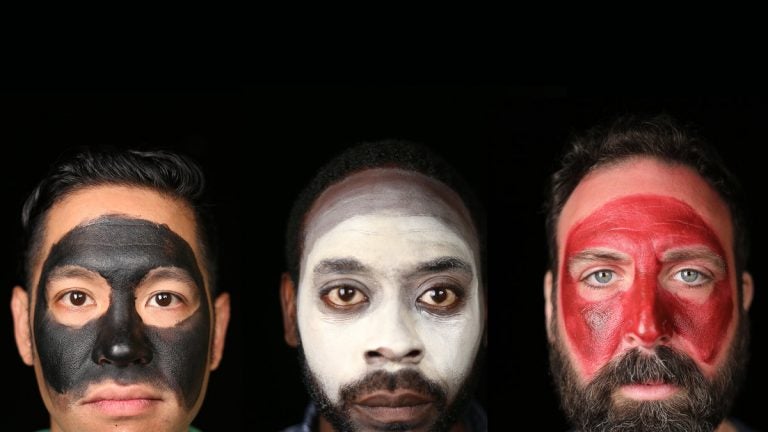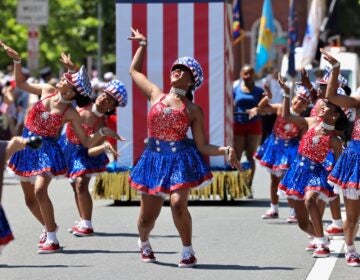Review: Race, theater and ‘An Octoroon’
Listen
In Wilma Theater's production of 'An Octoroon
Take something – anything — to outrageous extremes, and you might discover some new truth about it. That’s one of the points, it seems, of the wildly extreme play “An Octoroon,” a show as much about the way we buy into theatrical illusion as it is about the way we traffic in racial stereotypes.
I didn’t get to see “An Octoroon” in its two Off-Broadway productions over the last two seasons that drew high critical acclaim and a flood of ticket-buyers. Now, happily, I have. It opened in Philadelphia on Wednesday in a production by Wilma Theater — the perfect venue for something as edgy, risky, big, unlikely and challenging as “An Octoroon.”
Branden Jacobs-Jenkins’ play shifts directions and moods in flashes, and once you buy into its jarring rhythms, they strangely begin to make sense. Jacobs-Jenkins sees a story in a way most of us wouldn’t think to. It begins with a black playwright – Jacobs-Jenkins or some part of him – recounting conversations with his therapist (maybe) over his dispiriting lack of enthusiasm and his failure to get a play off the ground. That morphs into a monologue from a drunken long-dead Irish playwright, possibly Irish, telling us about his bad luck at being forgotten and ordering his valet around.
We come to learn that not enough actors will submit to work in the black playwright’s new production; the Irish playwright laments about not being able to find an American Indian actor for any role. There’s a way to solve this: the black actor (the remarkable James Ijames) puts on white-face so that he can play white roles in his play. The old drunken playwright (the remarkable Ed Swidey) smears on red-face to portray an American Indian in the play. His valet (the remarkable Justin Jain) rubs on black-face to portray a black slave butler and black overseer. (In case you missed it, the lead players are … well, I wrote it three times, and the rest of the cast is a match for them.)
Off we go to a failing plantation in the Louisiana bayou, the setting of the play they will put on — which is a loose adaptation of a real melodrama written in 1859 by a long-forgotten Irish playwright who surely couldn’t find any American Indians for his production if he’d tried. I can only hint at the tribulations that befall this plantation, or the convoluted nature of their telling. At one point Ijames, who plays someone from the good and troubled plantation and also the nasty owner of the plantation down the grove, gets into an unforgettable knife fight with both his characters at once (choreographed by Ian Rose). A well-dressed rabbit (Aaron Bell) at times wanders onto the beat-up stage (Matt Saunders’ design) to represent a dream, or fate, or the silliness of illusion, or possibly a rabbit.
The three slave women (Taysha Canales, Alina John and Jaylene Clark Owens) talk the way we might imagine when the massa’s around; on their own, they gossip merrily in current-day black street patois. (“Everybody finds the way you act kinda ghetto!” one admonishes another.) There’s a young Southern-belle future heiress (Maggie Johnson), and the plantation family’s own misfit (Campbell O’Hare), who becomes a major player in “An Octoroon” because she plays the title role – she’s an eighth black, from a tryst in the family’s past. There’s a love triangle. Bizarre interludes bombard moments of tenderness.
It’s all purposely clunky, and much of it is very funny and on the face of it, outrageously racist. But so racist, and in the context of so many extremes, that the racism exposes itself for its utter absence of rationale. One of Jacobs-Jenkins great gifts is his ability to twist storytelling norms: much of this makes no sense and, taken as a single piece, it all makes sense. He’s eloquent in his trickery: the black and white playwrights (in different greasepaint face colors) detail the artificial devices that traditionally make plots work – they’re all in this plantation play. They tsk-tsk-tsk about the superficiality that audiences buy into, then move on with the remainder of their trite play which, of course, we buy into. We find a sense of reality in the illusion their play creates – and when we find something actually real, we gasp in horror.
The much-respected director Joanna Settle — a go-to stager of both conventional and outré work and chief of the University of the Arts theater program – doesn’t get “An Octoroon” right in its first half. As a result, Act One and Act Two seem like two different plays at the Wilma. She has the seven-member hip-hop band Ill Doots on stage – a super-talented group that in the first half breaks into original songs several times. What are these songs and what do they have to do with anything? We’re already trying to parse the play itself. Now, “An Octoroon” becomes even more remote.
I had to wonder: What is Joanna settle thinking? That’s not facetious, it’s a real question. If I couldn’t make sense of this vacant theatricality, I assume the people around me couldn’t, either. The musical intrusions rupture a text that’s gradually beginning to take off. When you’re running a roller coaster, it’s a terrible idea to send people half-way up the first steep incline, then bring them back down to where the ride began.
Settle finds her footing in the second half, when Ill Doots backs the play up by poignantly orchestrating the mood the text creates, and Settle lets the actors do their jobs. Those jobs are not easy from the get-go; neither is this splendid play. It makes me think that the safe illusion theater creates may be the best platform for our hardest national discussion: about race, our national history with it, and people who are different from whatever we think we are.
Weirdly, a few days ago I was touring a plantation in the Louisiana bayou like the one depicted in “An Octoroon.” Early in the tour, a few of us tried to get the young guide to talk about slavery there. He demurred, bringing it up only once — toward the very end. He was a real-life example of avoiding The Discussion. In the extreme, he would make a perfect character in a sequel to “An Octoroon.” Does art imitate life, or is it the other way around?
_“An Octoroon” runs through April 10 at Wilma Theater, Broad Street between Locust and Spruce Streets. 215-546-7824 or www.wilmatheater.org.
WHYY is your source for fact-based, in-depth journalism and information. As a nonprofit organization, we rely on financial support from readers like you. Please give today.




